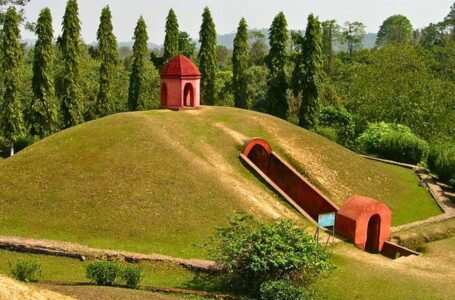Decoding The Six Yards of Pure Paithani Silk
- Lifestyle Asian history
 Bitati Kar
Bitati Kar- November 9, 2022
- 0
- 450
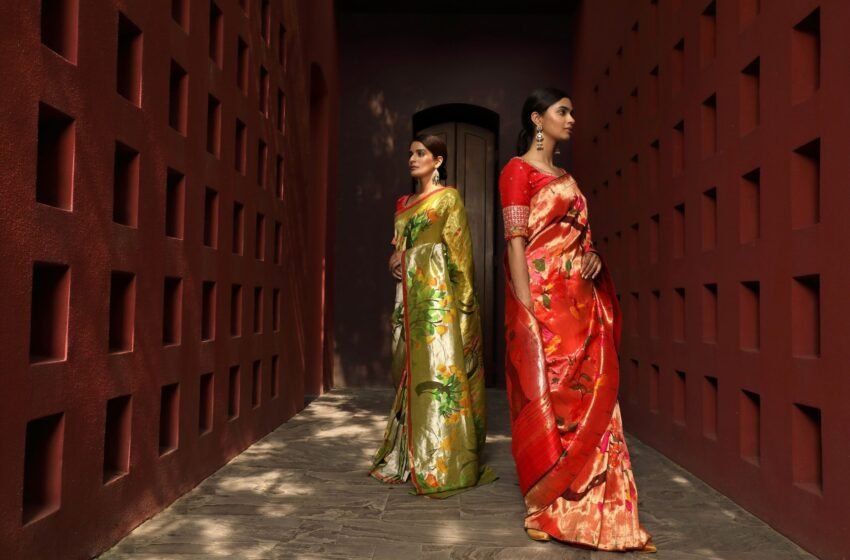
Paithani Silks The Royal Handlooms of Maharashtra
India has always been a land of cultures, traditions, festivals, and freedom. Since time immemorial, one of the most traditional clothing of Indians is sarees. Saree usually have a lot of variety but among all of them, the most comfortable and beautiful saree is a handloom saree. A ‘handloom’ is basically a loom that is used to weave the clothing without the use of any sort of electricity. The hand weaving is usually done on the pit looms or frame looms which are located in the weaver’s homes. It is high time we keep in mind this that weaving is primarily the interlacing of two sets of yarn which includes the warp which is known as the length and the weft which is known as the width. It is also important to note here that, handloom fabrics are made separately and can be distinguished from other fabrics due to their smooth and soft quality and also because of their manufacturing procedure. The fabrics are handwoven which leads to the quality becoming soft, smooth, and much more comfortable to wear.

Handloom sarees originated and are a traditional textile art of Bangladesh and India. The production of handloom sarees also plays a very important role in the economy of both urban and rural India. The creation of one single piece of saree can take two to three days of time. Different regions of India have different traditions of making handloom sarees. Apart from West Bengal which is known as the epitome of traditional handloom sarees, Paithani handloom which is usually made on Silk clothing in Maharashtra is very well known.
Paithani saree or “Pa-i-tha-ni” saree as known by people of Maharashtra and local regions, is a traditional handloom saree which was actually named after the Paithan town, previously located in the Aurangabad district in the state of Maharashtra in India. This type of saree was first made by hand by the weavers. Yeola town which is located in Nashik in Maharashtra is considered to be the largest manufacturer of Paithani sarees.
In the year 1712, the Nizam of Hyderabad Asaf Jah II had tried to introduce Paithani sarees to his court. Even though history highlights this incident, however it has also been traced and debated that the Paithani sarees were already woven at a village called Paithan near the Aurangabad region of Maharashtra. It has been said that since the early 17th century, Paithan has been an important center for producing silks.

The art of Paithan is considered to be more than 2000 years old and in Paithan there is told to be a city named Pratishthan which was ruled by the legendary and supreme Satavahanas ruler Shalivahana. This city is now located and merged in Paithan by the river Godavari in Marathwada which is nearly 50kms from Aurangabad. It has been written in history that back in the day, it used to be an international trade centre for things like silk and zari. The Peshwas are told to have a special love for Paithani textiles, during the 17th century the Mughal emperor Aurangazeb had patronised the Paithani silk weavers and they as an solution introduced new motifs which they named as Aurangazebi. The emperor had prohibited the weavers to weave sarees and a particular form of saree called ‘Jamdanis’ except for his royal court and had introduced punishment for those who did not obey the orders. It is pertinent to mention here that, as time flew by, and reforms came in, in the late centuries, the Nizam of Hyderabad had ordered large quantities of Paithani silks. The credits of helping India retain its glory of Paithani sarees. It has been told that because of the patronage of the household of the Nizam of Hyderabad, the Paithani handloom sarees still exist. Begum Niloufer, belonging to the Nizam family, is appreciated and known for her contribution to giving the Paithani sarees a new look. She has been attributed for her contribution to the motif Parinda which means a Pheasant bird.
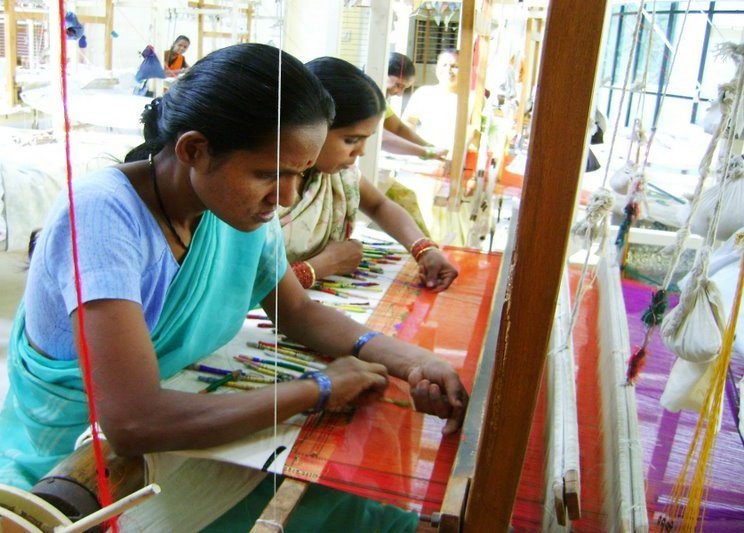
Human excellence has been replaced by modern machines in almost all areas, but it could not replace the mastery of human hands. No machine could compete with the handmade fabric that was made in Paithani sarees by the master craftsmen from Maharashtra.
Paithani saree is characterised by borders of oblique square design, it also has a padar with a peacock design. A lot of Paithani sarees are available in plain and spotted designs as well. The most popular variety of Paithani saree is single coloured kaleidoscope and colored designs, this effect and style is achieved by using one colour for weaving in lengthwise and another colour for weaving width wise.
The raw material that is used to make Paithani sarees is usually silk yarn, zari and colours. In most times filature silk is used as a warp and sidlaghatta or even a kind of charakha silk is used as weft. In recent times, Zari is more used than the other materials. Previously zari was drawn from pure gold, but due to some circumstances, it has been replaced by silver. This replacement is also a major reason behind Paithani becoming more affordable to the middle class people.
Paithani saree comes in various colours, some are pure and some are the result of the blending og yarns of different colours in the weave. One colour is usually made the dominant colour and kept in the border and the Pallov of the saree is made with a different color from that of the body. The local designs also have names based on their color combinations, aboli style is called the peach-pink style of Paithani, firozi is the white-red-pale green shade and style of the Paithani saree. There are also many other styles with different names based on their colors.
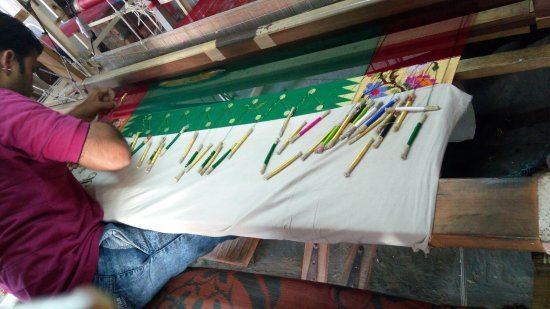
A typical Paithani saree is heavyweight and contains bright colors, has butti with pallov and solid zari border. Each and every Paithani saree is woven to a standard size of 6¼ th yard which also includes quarter of blouse piece. One Paithani saree consumes about 500 to 575 grams of silk and 200 to 250 grams of zari. A finished Paithani depending on its type may weigh from 600 to 750 grams. The width of its border usually ranges from 7 to 9 inches. Borders are usually named after the motifs used in them or sometimes also named after the village from where they originated from, e.g. Asavalikath.
The oldest traditions of Paithani designs are mainly vine and flowers, named Asavali. Another prominent traditional design is squarish floral motifs known as the Akruti. There are many motifs which are inspired from the Mughals as well.
Paithani handloom is considered to be at its peak of popularity during the reign of the Peshwas. The Peshwas had always loved Paithani textiles much more as mentioned by researchers and historians. The credits have been given to them to continue this heritage in India and also at the same time add more designs and colours to it. Almost all weavers of Paithani sarees mainly belong to the Paithan and Yeola district of Maharashtra in India.
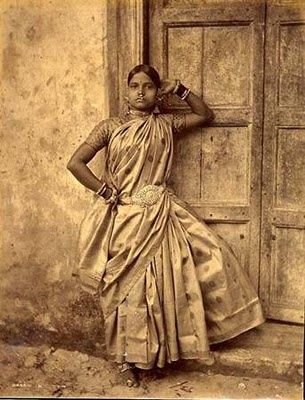
The decline in the production of Paithani sarees began with the revolution of industries. The production of cheap fabric, produced in the mills has caused a heavy blow on the hand woven traditional market. The number of looms in Paithan also have gradually started decreasing. In the early stages the weaving activities were limited to Paithan town till the start of the 17th century. After that the weaving activities were transferred to Yeola which is a village in the Nashik district, and was growing with the help of local wealthy people. The market of Paithani saree started growing from 1984 and 1985 and Yeola village was the main commercial centre of the production of Paithani sarees.
A low priced variety of artificial silk and zari has recently emerged in the market, which has possessed a great threat to the traditional Paithani sarees. The low production cost of the cheap fabric has increased the problems present in the fashion and other industries, owing to its cheap costing the traditional Paithani saree made of pure silk and gold brocade has lost its value because people prefer to wear the duplicate version of a clothing rather than appreciating and valuing the original art. This hazard has led to the threat of the existence of the original weave. However, like always just as any trend starts it ends as well, this imitation also fell short and people are now trying their best to support the original weavers of Paithan, because their craft, texture, designs are something which was not fully possible to imitate. Paithani sarees have become a must wear article during weddings and especially for the brides. It has spread its colors and expanded through many horizons.

Paithani is the oldest form of art in the field of weaving and has a legacy of more than 2200 years. However, despite, the qualities and extraordinary features of the Paithani handloom, the original and native Paithani weavers need to face extreme challenges. One of the worst challenges for them is the copying or duplication of their work without their knowledge, due to this some weavers are also migrating to their native districts and putting a stop at the production. It is pertinent to mention here that, due to the duplication of work, the original and real heritage might get lost amidst this and can create grave consequences for our history and culture. Paithani saree is most commonly used as an highly prestigious attire for marriages, but due to duplication more number of false Paithani sarees are available than the real ones. This issue has taken the front seat with such an force that the weavers have even refused to teach their own children. The art is at a high risk of becoming extinct.
According to various reports the market for handcrafted products is huge, while the talents is less in comparison to that. However it is important to note that, we need to find the perfect balance between economy, art, and talent and create a cycle which is completely or 99% at par with the cycle our Mother Nature has created. The problems are many and the solutions are less, but we cannot resort to any means which might turn out to be deadly for our culture. The lack of authenticity has reduced the global market for handcrafted products, this can be curbed by legal means like copyright issues and stuffs. It is also important to note here that the handloom sector needs to be developed in the urban societies just like it is in the rural sectors, this way the production cost can be decreased while the production will be increased.
Thus it can be concluded from here that the challenges faced by the artisans have been long ignored and also is something very vital for our culture. It is also important to note here that, creation takes much more effort in comparison to the revenue generated, the artisans not only need to work as they like, instead they need to work as you would like to wear which makes the process more tiring and exhausting. There is an urgent need for each and everyone of us to come together and protect our culture, and help develop our rural handicraft departments. It is high time we start valuing and give back the artisans for what they truly deserve, instead of denying the truth.
